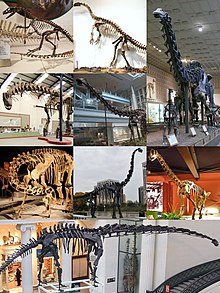Sauropodomorpha
| Sauropodomorphs Temporal range:
| |
|---|---|

| |
| Montage of nine different representatives of sauropodomorph dinosaurs. Clockwise from upper left: Brachiosaurus altithorax .
| |
| Scientific classification | |
| Domain: | Eukaryota |
| Kingdom: | Animalia |
| Phylum: | Chordata |
| Clade: | Dinosauria |
| Clade: | Saurischia |
| Clade: | Eusaurischia
|
| Clade: | †Sauropodomorpha Huene, 1932 |
| Subgroups | |
| |
Sauropodomorpha (
Description
Sauropodomorphs were adapted to browsing higher than any other contemporary herbivore, giving them access to high
Their
One of the earliest known sauropodomorphs,
Initially
They also had large nostrils (nares), and retained a thumb (pollex) with a big claw, which may have been used for defense — though their primary defensive adaptation was their extreme size.
Distinguishing anatomical features
Sauropodomorphs can be distinguished as a group on the basis of some of the following
- The presence of large nares.
- The distal part of the tibia is covered by an ascending process of the astragalus.
- Their hind limbs are short when compared to their torso length.
- The presence of three or more sacral vertebrae.
- The teeth are thin, flat and are spatula-like, with bladed and serrated crowns.
- The presence of a minimum of 10 cervical vertebrae that are typically elongated
- The presence of 25 presacral vertebrae
- The manus had a large digit I.
Evolutionary history
Among the first dinosaurs to evolve in the
The earliest and most
Classification


Sauropodomorpha is one of the two major
In
Most modern classification schemes break the prosauropods into a half-dozen groups that evolved separately from one common lineage. While they have a number of shared characteristics, the evolutionary requirements for giraffe-like browsing high in the trees may have caused convergent evolution, where similar traits evolve separately because they faced the same evolutionary pressure, instead of (homologous) traits derived from a shared ancestor.[11]
Phylogeny

Cladogram after
| Sauropodomorpha |
| |||||||||||||||||||||||||||
The phylogenetic analysis of Otero et al., 2015 found Sauropodomorpha to be in a polytomy with
Below is a cladogram of basal sauropodomorpha after Müller, 2019.[14]
| Sauropodomorpha |
| ||||||||||||||||||||||||||||||||||||||||||||||||||||||||||||||||||||||||||||||||||||||||||||||||||||||||||||||||||||||||
Paleobiology
Comparisons between the
Sauropodomorphs reached the age of sexual maturity well before they were fully-grown adults.[16][17] A study by Griebeler et al. (2013) concluded that the maximum growth rates of sauropodomorphs were comparable to those of precocial birds and the black rhinoceros but lower than the growth rates of average mammals.[17]
A long-standing hypothesis has been that early sauropodomorphs were carnivorous, as expected for most early dinosaurs. This hypothesis is supported by the current basalmost sauropodomorph,
References
- .
- OxfordDictionaries.com. Archived from the originalon November 1, 2015. Retrieved 2016-01-20.
- ISBN 1-4051-3413-5.
- S2CID 92177386.
- PDF)
- PMID 19209223.
- S2CID 33506648.
- .
- ^ Yates, Adam M. (2007). Barrett, Paul M.; Batten, David J. (eds.). "The first complete skull of the Triassic dinosaur Melanorosaurus Haughton (Sauropodomorpha: Anchisauria)". Evolution and Palaeobiology: 9–55.
- ^ S2CID 128620874.
- PMID 21298087.
- hdl:11336/38019.
- S2CID 205254710.
- S2CID 209575985.
- S2CID 33253407.
- S2CID 86183725.
- ^ PMID 23840575.
- ^ PMID 27839975.
- ^ S2CID 86006363.
- PMID 21490016.
- ^ Hendrickx, C.; Hartman, S.A.; Mateus, O. (2015). "An Overview of Non- Avian Theropod Discoveries and Classification". PalArch's Journal of Vertebrate Palaeontology. 12 (1): 1–73.
Sources
- .
External links
- Sauropodomorpha: Overview, from Palæos.
- Sauropodmorpha Archived 2019-07-02 at the Wayback Machine, from When Dinosaurs Ruled Texas, by Jon A. Baskin.
- Geol 104 Dinosaurs: A natural history: Sauropodomorpha: Size matters, by Thomas R. Holtz Jr., from the University of Maryland.
 Data related to Sauropodomorpha at Wikispecies
Data related to Sauropodomorpha at Wikispecies















